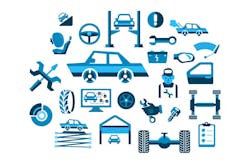Of the hundreds of collision repair shops Dean Ricciardulli claims to have visited in his 28-year career in the industry—which has included stints at Mitchell, eMarketing Sherpas and PartsCheck Live—he says very few of them can even identify what an opt OE part is.
“There’s a challenge there—absolutely,” says Ricciardulli, manager of global OEM relations and business development at ALLDATA. “The complexity of parts and categories of parts is reaching new levels and it takes time and effort to understand it all.”
Helping to educate shop owners on that complexity is a task in and of itself. But going one step further, John Shoemaker, business development manager for BASF Automotive Refinish North America, says there’s an even more important task at hand: educating customers and insurance companies.
“A lot of what shops present to the customers about parts is negative,” Shoemaker says. “A lot of times, we’re pushing our frustrations with insurance companies on to our customers, and it creates a hostile environment.”
So when it comes to negotiating with insurance companies, communicating with customers paying out of pocket, and informing customers of the parts going on their cars, Shoemaker and Ricciardulli suggest a healthier approach: Understand the various parts categories and then talk about the advantages and disadvantages of each.
Here’s what you need to know about the various parts categories and how you should talk about them with customers and insurance companies.
The Parts Categories
It all starts, of course, with an understanding of the parts classifications you’re likely to encounter. Shoemaker and Ricciardulli put together a few basic definitions to help out:
OE: Original equipment (OE) parts are made by the car manufacturer or a vendor according to the OEM's specifications.
Aftermarket: Parts made by a vendor based on information they attain about OE parts, not necessarily to the manufacturer’s specifications.
Opt OE: Here, there is confusion around the name, sometimes referred to as opt-alt OE. Essentially, Shoemaker and Ricciardulli define these as OE parts that are sold by a vendor and not a dealer franchisee.
“Over the last five years, the number of auto dealerships has decreased, leaving all this stock they had to get rid of,” Shoemaker says. “So they sold it to clearinghouses and they’re selling it as opt OE because they’re not franchisees. It’s commonly seen as another avenue to get better pricing.”
Salvage: Undamaged parts that have been taken off a vehicle that’s been rendered salvaged (due to an accident or flooding).
Remanufactured: Used parts that were taken apart and fitted with new components. These are parts that have been taken off a wrecked vehicle and repaired.
“The OE knows exactly when that airbag needs to go off based on the vehicle's design.”
John Shoemaker, Business Development Manager, BASF
OE vs. Aftermarket
Both Shoemaker and Ricciardulli agree: If you’re dealing with a vehicle less than a few years old, then you should have a zero-tolerance policy with OE parts versus aftermarket parts.
“If it’s a 2016 car, you can’t compromise and put aftermarket parts on it, because there hasn’t been enough time for the aftermarket to produce a similar product,” Shoemaker says. “You should present an argument to the insurance company to make sure they’re doing the job that the customer deserves.”
The discussion isn’t just for insurance companies—customers paying out of pocket should understand the risk they’re taking by putting aftermarket parts on their vehicles, Shoemaker says.
This is especially true when it comes to safety-related parts, Ricciardulli says, such as brakes, steering and suspension components. Keep the customer the focal point of the conversation when discussing OE versus aftermarket parts with insurers, and use OEM position statements when negotiating to show you’re just following procedure.
“I could use an OE position paper and show that I don’t have to put this aftermarket part on it because the OE position is that these airbags are safer,” Shoemaker says. “There are apparently up to 80 sensors read off of a headlight on a Mercedes. The aftermarket can’t duplicate that.”
Don’t hesitate to go beyond the position paper and physically show why one part is safer than another.
“You could lift up an aftermarket and OE core support and definitely tell the weight difference. Well, that’s where all the airbag sensors are mounted,” Shoemaker explains. “So if that part isn’t crushing at the same rate as the OE, then there could be a delay in the airbag. The OE knows exactly when that airbag needs to go off based on the vehicle’s design.”
If you’re negotiating with an insurance company over parts, keep the customer separate from the conversation. Shoemaker says that can bring negative energy to the customer experience, deterring them from returning in the future.
Shoemaker adds that while OE parts are generally a safer bet, there are plenty of times to consider aftermarket options.
“Absolutely aftermarket parts have a place in our industry, especially when trying to save a vehicle from a total loss, as long as safety is not compromised,” he says. “Also, aftermarket parts manufacturers create parts that are no longer available through [the] OEM.”
However, if you’ve decided to use an aftermarket part on a vehicle, Shoemaker says you have an obligation to at least explain it to the customer.
“Have an aftermarket part position letter and the invoice ready, and explain to them, ‘This is a part we could not convince your insurance company to replace,’” he says. “ I think if the shop has done its due diligence to explain it to the customer, if they’ve shown they’ve gone through all their resources, then you won’t get burned.”
Opt OE
The definition of opt OE parts tends to vary and is often vague, Ricciardulli says, which makes your ability to effectively communicate about them crucial.
Many OEMs have programs that sell opt OE parts. Opt OE Ford parts are offered through the OE Reman Direct program; GM uses the GM Outlet Shop; Hyundai has Car Care Parts; Chrysler, Honda, Nissan and Infiniti do not offer opt OE parts.
The line between each program will begin to blur with each program, though, complicating what “opt OE” means for each repair. For instance, opt OE Ford parts are classified under “refinished” (parts that have been blemished) and “surplus” (parts with no blemishes). So be sure to communicate with whomever you buy opt OE parts from so you can explain whether the part meets safety requirements for insurance companies and customers.
For more information on the confusion regarding the proper title and definition for opt OE parts, see the story “New Parts Classification Causes Confusion” in the November 2016 issue of FenderBender.
Salvage, Remanufactured and Reconditioned
Salvage parts are often classified as “recycled” parts. However, the term “recycled” isn’t used like it is for recycling aluminum cans and glass bottles—recycled parts refer to parts that have been removed and resold with little to no work performed on them.
There are plenty of positive aspects to communicate about salvage and remanufactured parts, such as energy conservation (parts are kept out of the resmelting process longer during remanufacturing) and landfill space conservation.
However, at the end of the day, Shoemaker and Ricciardulli agree that these parts need to be seriously vetted before installation, especially when compared against OE parts.
“You have to have a face-to-face conversation with the customer if a salvage part is used,” Shoemaker says. “We’re in such a litigious society now. You need to do everything you can to cover yourself.”

